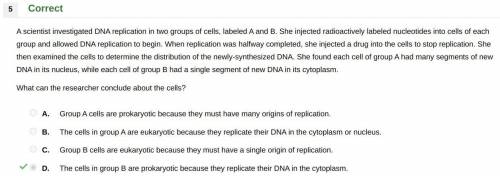
Biology, 12.10.2020 20:01 Michcardwell1071
A scientist investigated DNA replication in two groups of cells, labeled A and B. She injected radioactively labeled nucleotides into cells of each group and allowed DNA replication to begin. When replication was halfway completed, she injected a drug into the cells to stop replication. She then examined the cells to determine the distribution of the newly-synthesized DNA. She found each cell of group A had many segments of new DNA in its nucleus, while each cell of group B had a single segment of new DNA in its cytoplasm.
What can the researcher conclude about the cells?
A. Group A cells are prokaryotic because they must have many origins of replication.
B. The cells in group A are eukaryotic because they replicate their DNA in the cytoplasm or nucleus.
C. Group B cells are eukaryotic because they must have a single origin of replication.
D. The cells in group B are prokaryotic because they replicate their DNA in the cytoplasm.
D. The cells in group B are prokaryotic because they replicate their DNA in the cytoplasm.
I hope this helps.


Answers: 2


Another question on Biology

Biology, 22.06.2019 10:00
Based on the observation that only male crickets produce a song, you hypothesize that a male's song is a form of communication to potential mates. you set up a simple experiment to test this hypothesis. in the laboratory, you place a male snowy tree cricket in enclosure a, which is adjacent to enclosureb. in enclosure b, you place other insects, one at a time, and observe their responses to the male's song. the enclosures are designed so that the two insects being tested cannot see or smell each other, but sound is transmitted from enclosure a to enclosureb.
Answers: 1



Biology, 22.06.2019 14:00
Which tool could you see a plant cell? a. a filter b. a microscope c. a microwave d. an electromagnet
Answers: 1
You know the right answer?
A scientist investigated DNA replication in two groups of cells, labeled A and B. She injected radio...
Questions



Mathematics, 04.10.2020 14:01

World Languages, 04.10.2020 14:01



Mathematics, 04.10.2020 14:01

English, 04.10.2020 14:01



English, 04.10.2020 14:01



Computers and Technology, 04.10.2020 14:01



Mathematics, 04.10.2020 14:01

Mathematics, 04.10.2020 14:01


English, 04.10.2020 14:01



